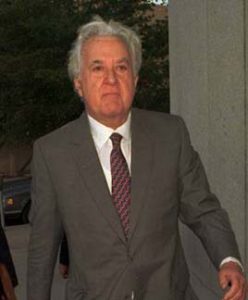By Lucy Komisar
AlterNet, Dec 22, 2004
How insurance companies are aiding tax evasion by over-charging in America and shipping the money to offshore firms.
Terry Mills was working in Wilmington, Del., for J. Montgomery, one of the largest insurance agencies in the region, when in 1993 he was called in to get to the bottom of a messy insurance problem. Little did he know that he would uncover a story – as yet unreported – about tax evasion through offshore firms,  but with a twist. The scheme Mills came across seemed to be taking place with the aid of AIG, a major U.S. insurance giant.
but with a twist. The scheme Mills came across seemed to be taking place with the aid of AIG, a major U.S. insurance giant.
The case Mills was sent to look into had to do with a Delaware holding company named NVF Corp., which owned a vulcanized fiber factory, and which was being reorganized. The reorganization was prompted by a federal court order which enjoined its owner, Victor Posner, from acting as officer or director of any public company.
Posner, who died in 2002, long had a reputation as the original corporate raider, famed for engineering hostile takeovers of companies and looting them. He had a history of corrupt dealings.
For instance, Posner and his son Steven, along with Drexel Burnham Lambert, Inc., had been defendants in a 1988 SEC complaint about a stock parking scheme to gain control of the Fischbach Corporation that the SEC said cheated investors of about $4 million.
But more relevant to what Mills was dealing with in 1993, it turns out that Victor Posner and NVF had a relationship going back at least to 1977. That was the year when the SEC had filed a complaint against Sharon Steel Corporation, its holding company NVF, and several individuals, including Victor Posner, for a litany of corporate and individual misdeeds, including treating assets of public corporations as their private property.
In 1987, Victor Posner pleaded no contest to evading more than $1.2 million in taxes and was ordered to pay $7 million in fines and back taxes.
Even so, Mills was astonished when he examined the NVF insurance books. The company I was with [J. Montgomery] had the opportunity to write the insurance for NVF in the period after the SEC gave Posner the cease and desist, Mills told me. He said he found that, The senior management really didn’t have a handle on what the costs were.
Mills found a curious pattern: NVF had been paying National Union Fire of Pittsburgh, an AIG company, substantially over market for workmen’s compensation insurance. He told Catherine Mulholland, director of the Delaware Insurance Department’s bureau of examination, that when he went to buy workers comp, he found it was only half as much as the year before.
Mills told me, The fronting company was AIG. And the broker on the deal was Alexander. It was one of the biggest brokers in the world.
Here’s how the deal worked: Insurance companies normally insure themselves by laying off part of their risk to reinsurance companies, so if a claim comes in above a certain amount, the reinsurance company will pay it. AIG had reinsured the NVF policy through a company named Chesapeake Insurance, a reinsurance company based in Bermuda. It turned out that Chesapeake was owned by Posner.

In essence, NVF, owned by Posner, was buying insurance from an AIG company – which was buying reinsurance for the policy from an offshore company owned by Posner. And Bermuda provided the tax and secrecy haven, so Chesapeake’s books were safe from the eyes of American regulators and tax authorities.
The transaction meant all the parties came out ahead: AIG would keep a portion of the allegedly inflated NVF premium before sending the rest to Chesapeake, which meant AIG would have a higher commission. Posner would write off the entire amount as a business expense and enjoy the extra cash in Bermuda, tax free. Reduced profits might also mean smaller dividends and share prices.
A former insurance department regulator, using hypothetical numbers, explains, Say the normal premium was $1 million. [If I ran the company,] AIG could charge me $2 million and then send a premium of $900,000 over to a reinsurance company that it has set up for me in Bermuda. I never have to pay any claims, so I get to keep the $900,000 tax-free offshore.
This was not an isolated case with Vulcan. AIG did that a lot, he claims, speaking under condition of anonymity. AIG helped companies set up offshore captive reinsurance companies. AIG, he alleges, would then overcharge on insurance and pay reinsurance premiums to the captives, giving the captive owners tax-free offshore income. He adds, Doug McLeod [editor of Business Insurance] told me that there were captives that hardly ever paid any claims.
McLeod told me, Looking at the schedule F, the reinsurance schedule, of one of the AIG companies, they had a captive. They reported a pretty large amount of premiums ceded, sent to that captive, but very little in claims payments coming back. That is unusual. Why would a captive of a large company collect that amount of premium and not pay any claims? They could have gone through a loss-free year, but it doesn’t seem likely.
The captive scheme is a variant of transfer pricing or profit laundering, whereby companies inflate the cost of purchases or services from tax havens in order to boost their home country expenses and move profits to tax-free jurisdictions. It might also hurt shareholders, since dividends could be reduced by the company’s cost of inflated premiums.
Mills cancelled the NVF policy with AIG. We were able to find them coverage in the standard market, he says. We started a new policy in late 1993.
However, it seems the Delaware Insurance Department took no action against the insurer.

Provided the details of what AIG allegedly did, company spokesman Andrew Silver says simply, We don’t have any comment on that.
AIG declares on its website that it pioneered the formation of captives almost 60 years ago, and it offers management facilities to run the captives in offshore Barbados, Bermuda, Cayman Islands, Gibraltar, Guernsey, Isle of Man, and Luxembourg – all places where corporate and accounting records are secret and taxes minimal or nonexistent.
There is reason to suspect the pattern discovered by Mills is being duplicated elsewhere. For instance, Marsh, the insurance brokerage recently charged by New York Attorney General Eliot Spitzer with bid-rigging, also runs the Marsh Captive Management Group to help corporate customers set up reinsurance companies in offshore Barbados.
There is a link between Marsh and AIG: Maurice (Hank) Greenberg heads AIG, while Marsh was being run by his son, Jeffrey, until he was fired after the bid-rigging charge was made.

There are more captive insurance companies in Bermuda than any place else, says David Schiff, editor of Schiff’s Insurance Observer. The whole purpose is that it’s not regulated by the U.S. Rates are not supposed to be too high or low, but [regulators] are usually looking to protect consumers. How do they tell us Microsoft is paying too much for workers comp? There’s no way for a regulator to know that.
Fraud is hard to find unless you get tipped off, he adds.
An insurance broker and risk management consultant says, of the captive arrangement, It’s common; that’s the way it’s done. He adds that oil companies all have offshore captives. And McLeod says that several oil companies were joint shareholders of the Oil Insurance Ltd, an oil company group captive.
There are more than 1,800 captive insurance companies based in Bermuda with over 60 percent owned by American interests.
A majority of fortune 500 companies have captives, says McLeod. He pulls out a copy of the Tillinghast Captive Directory and ticks off U.S. companies with Bermuda captives: Levi Strauss: Majestic Insurance International; Caterpillar Tractor: Caterpillar Insurance Co. Ltd., FMC Corp (tractors): Financial Reassurance Co and Transcon Insurance, Carnival Corp.: Trident Insurance, all managed by Marsh. Other big firms with captives were Schlumberger (oil field services): Harrington Sound Insurance and Castle Harbour Insurance, managed by JLT, and United Van Lines: Vanliner Reinsurance managed by Codan Management.
Reinsurance has always been a traditional way of moving money, the broker says. You can do a ‘rent-a-captive’ where you don’t even have to set up your own captive, you just run the funds through a bookkeeping system: it’s even cheaper. The question is whether the IRS lets you get away with it.
In 2002, the IRS and the Treasury department required transactions with captives to trigger disclosure, list-maintenance, and registration requirements based on information that many of these arrangements were being used to shift income improperly to PORCs [Producer-Owned Reinsurance Companies] for purposes of avoiding income tax.
However, in September 2004, the administration abolished that rule. IRS Commissioner Mark W. Everson explained that, Based on disclosures by taxpayers and examination of tax returns, we have determined problems associated with these transactions are not as prevalent as initially believed.
Of course, fraudulent use of offshore captives is hardly likely to be disclosed by taxpayers or noted on tax returns. Spokesmen at Treasury and the IRS declined to discuss the issue.
Following indictments for alleged bid-rigging against Marsh insurance company officials brought by Spitzer, officials in other states are looking more broadly into insurance practices. Asked about whether Spitzer was checking into the abuse of offshore captives, his spokesman declines to comment.
It’s an area that should be examined by state and federal investigators.

